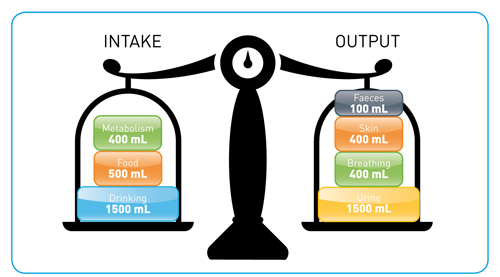Hidratación en invierno
In cold climates, body fluid losses can be as high as those in hot climates because of high rates of energy expenditure, use of heavy clothing and increased losses in urine1,2.
Under normal conditions, urine and sweat are the main methods of water loss, but we also lose water via the skin, the lungs, and the faeces. These losses vary widely depending on fluid intake, diet, activity level, temperature and clothing2,3.
Normal water balance

In cold weather conditions, additional water losses occur as a result of increased urine and respiratory water losses. Some water is also lost through the skin as a result of heavy clothing and because sweat evaporates quickly in cold, dry air.
Respiratory losses
Daily respiratory water loss is normally about 250 to 350 mL/day4, but the actual amount lost is influenced greatly by environmental conditions (air temperature and humidity and wind speed) and the level of physical activity3. Winter activities such as skiing, snowboarding and ice-skating can therefore greatly increase water loss:
- Breathing cold, dry air can increase respiratory water loss by approximately 5 mL/hour1, so this effect in itself is generally rather small for short exposures, but becomes meaningful when living in very cold climates and exposed to these conditions for 24 hours per day.
- Stressful physical exercise in cold weather can increase this loss to approximately 15 to 45 mL/hour1because of the increased rate and depth of breathing.
Urine losses
As the body gets colder, water loss as urine increases due to a higher urination rate, a physiological response known as cold-induced diuresis, which produces urine of low specific gravity* 2,3.
Read more about this topic and find a downloadable pdf of Key Tips on Hydration: Hydration in Winter
1. Freund BJ, Young AJ. 1996. Environmental influences on body fluid balance during exercise: Cold exposure. In: Buskirk ER, Puhl SM, eds. Body Fluid Balance: Exercise and Sport. Boca Raton, FL: CRC Press. Pp. 159–181.
2. EFSA Panel on Dietetic Products, Nutrition, and Allergies (NDA); Scientific Opinion on Dietary reference values for water. EFSA Journal 2010; 8(3):1459. Available at: www.efsa.europa.eu/en/efsajournal/pub/1459.htm
3. Panel on Dietary Reference Intakes for Electrolytes and Water (2005) Dietary reference intakes for water, potassium, sodium, chloride, and sulphate. National Academy Press: Washington DC.
4. Hoyt RW, Honig A. 1996. Environmental influences on body fluid balance during exercise: Altitude. In: Buskirk ER, Puhl SM, eds. Body Fluid Balance: Exercise and Sport. Boca Raton, FL: CRC Press. Pp. 183-196.